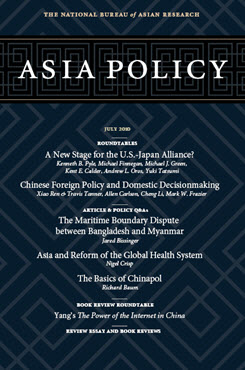The Maritime Boundary Dispute Between Bangladesh and Myanmar
Motivations, Potential Solutions, and Implications
This article examines the major catalysts of the surge in activity over the maritime boundary dispute between Myanmar and Bangladesh and explores both the likely avenues for resolution and the resulting implications for the two countries and the region at large.
This article examines the major catalysts of the surge in activity over the maritime boundary dispute between Myanmar and Bangladesh and explores both the likely avenues for resolution and the resulting implications for the two countries and the region at large.
MAIN ARGUMENT
The recent push to delimit the maritime boundary between Bangladesh and Myanmar stems from two factors. First, there are strong prospects for newly accessible gas in the overlapping claims. Speculation about gas prospects results from advances in offshore drilling technology that allow exploration in new swathes of the geologically promising but disputed ocean. Second, there is heightened demand for natural gas by the two countries. The growing demand for natural gas in Bangladesh, which has experienced power shortages, constitutes a major domestic political issue. Demand for gas has also grown rapidly in potential export markets, creating strong incentives for Myanmar to export gas in order to bring in foreign reserves and gain favor with countries such as China and India.
Bangladesh and Myanmar are actively pursuing a settlement through bilateral negotiations and the International Tribunal for the Law of the Sea (ITLOS). Both maritime baselines and the legal principles for defining exclusive economic zones will be key issues in the proceedings.
POLICY IMPLICATIONS
- A maritime boundary agreement would allow Bangladesh and Myanmar to begin exploiting potential resources, which could help alleviate Bangladesh’s gas crisis and bring more foreign reserves to Myanmar.
- Gas discoveries in Myanmar’s newly delineated maritime territory will likely rouse competition for gas exports between China and India similar to that over gas from the Shwe fields.
- Gas discoveries in the overlapping claims area offer the opportunity for Myanmar to create stronger economic, strategic, and political links with India.
- Development of energy infrastructure in northwestern Myanmar will disproportionately challenge the livelihood of the Rohingya.
- Some scope exists for regional multilateral organizations, especially BIMSTEC, to help engender cooperation in the Bay of Bengal region.
- If settled through the ITLOS, the dispute could provide legal precedent that affects future maritime boundary cases elsewhere.
About Asia Policy
Asia Policy is a peer-reviewed scholarly journal presenting policy-relevant academic research on the Asia-Pacific that draws clear and concise conclusions useful to today’s policymakers. Asia Policy is published quarterly in January, April, July, and October and accepts submissions on a rolling basis. Learn more


